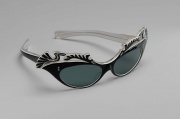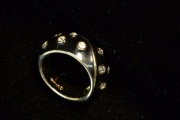Difference between revisions of "Rhinestone"
(username removed) |
|||
| (2 intermediate revisions by one other user not shown) | |||
| Line 1: | Line 1: | ||
| − | [[File:2005.188-SC172948.jpg|thumb| | + | [[File:2005.188-SC172948.jpg|thumb|Sunglasses<br>MFA# 2005.188]] |
== Description == | == Description == | ||
| + | [[File:rhinestonering.jpg|thumb|Leaded glass stone]] | ||
| + | An inexpensive, imitation [[gemstone|gemstone]] that simulates the appearance of a [[diamond|diamond]], but is much softer. Rhinestones originally were made from [[rock%20crystal|rock crystal]] (transparent [[quartz|quartz]]) found in or near the Rhine River. They were cut and polished to simulate diamonds. In 1775, a French jeweler, George Stass, began coating the bottom of the rock crystals to increase their reflectivity. The Aurora Borealis diamond was introduced in 1955 in which a coating was applied to the surface of the rock crystals to produce interference colors. This coating was later applied to rhinestones made of acrylic plastic. [[Paste%20diamond|Paste diamonds]], made from highly refractive glass, are also called rhinestones. Paste diamonds lack the double refraction and regular molecular arrangement of true gemstones. | ||
| − | |||
| − | |||
| − | |||
== Synonyms and Related Terms == | == Synonyms and Related Terms == | ||
| Line 13: | Line 12: | ||
[[media:download_file_432.pdf|Natural and Simulated Diamonds]] | [[media:download_file_432.pdf|Natural and Simulated Diamonds]] | ||
| − | + | ==Resources and Citations== | |
| − | |||
| − | == | ||
* G.S.Brady, ''Materials Handbook'', McGraw-Hill Book Co., New York, 1971 Comment: p. 364 | * G.S.Brady, ''Materials Handbook'', McGraw-Hill Book Co., New York, 1971 Comment: p. 364 | ||
| − | * ''Encyclopedia Britannica'', http://www.britannica.com Comment: "rhinestone." | + | * ''Encyclopedia Britannica'', http://www.britannica.com Comment: "rhinestone." Acccessed 14 Sept. 2005 . |
| − | * Wikipedia | + | * Wikipedia: http://en.wikipedia.org/wiki/Rhinestone (Accessed Sept. 14, 2005) |
* Random House, ''Webster's Encyclopedic Unabridged Dictionary of the English Language'', Grammercy Book, New York, 1997 | * Random House, ''Webster's Encyclopedic Unabridged Dictionary of the English Language'', Grammercy Book, New York, 1997 | ||
Latest revision as of 15:59, 24 August 2022
Description
An inexpensive, imitation Gemstone that simulates the appearance of a Diamond, but is much softer. Rhinestones originally were made from Rock crystal (transparent Quartz) found in or near the Rhine River. They were cut and polished to simulate diamonds. In 1775, a French jeweler, George Stass, began coating the bottom of the rock crystals to increase their reflectivity. The Aurora Borealis diamond was introduced in 1955 in which a coating was applied to the surface of the rock crystals to produce interference colors. This coating was later applied to rhinestones made of acrylic plastic. Paste diamonds, made from highly refractive glass, are also called rhinestones. Paste diamonds lack the double refraction and regular molecular arrangement of true gemstones.
Synonyms and Related Terms
rock crystal; paste diamond; Cornish diamond; strass; costume diamonds; Aurora Borealis
Comparisons
Natural and Simulated Diamonds
Resources and Citations
- G.S.Brady, Materials Handbook, McGraw-Hill Book Co., New York, 1971 Comment: p. 364
- Encyclopedia Britannica, http://www.britannica.com Comment: "rhinestone." Acccessed 14 Sept. 2005 .
- Wikipedia: http://en.wikipedia.org/wiki/Rhinestone (Accessed Sept. 14, 2005)
- Random House, Webster's Encyclopedic Unabridged Dictionary of the English Language, Grammercy Book, New York, 1997
- The American Heritage Dictionary or Encarta, via Microsoft Bookshelf 98, Microsoft Corp., 1998

